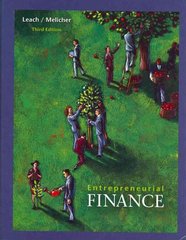Answered step by step
Verified Expert Solution
Question
1 Approved Answer
See Attached Word Doc You own a portfolio that has $1,650 invested in Stock A and $3,900 invested in Stock B. If the expected returns
- See Attached Word Doc
- You own a portfolio that has $1,650 invested in Stock A and $3,900 invested in Stock B. If the expected returns on these stocks are 11 percent and 16 percent, respectively, what is the expected return on the portfolio?
|
| Required: | |
| (a) | What is the arithmetic return for the stock? |
|
|
|
|
| (Click to select) 8.17% 9.80% 8.58% 8.37% 8.27% |
| (b) | What is the geometric return for the stock? |
|
|
|
|
| (Click to select) 9.49% 7.95% 7.85% 8.41% 7.65% |
- A stock has a beta of 1.3, the expected return on the market is 12 percent, and the risk-free rate is 5.4 percent. What must the expected return on this stock be?
- XYZ's returns are normally distributed. XYZ has a mean (expected return) of 14% and a standard deviation of 4%. What is the probability that XYZ will return less than 22%?
- XYZ's returns are normally distributed. XYZ has a mean (expected return) of 14% and a standard deviation of 4%. What is the probability that XYZ will return more than 22%?
- ABC stock is expected to produce a return of 14% with a 60% probability, and a return of 8% with a 40% probability. What is the standard deviation of the returns of ABC stock?
- You own a stock portfolio invested 30 percent in Stock Q, 15 percent in Stock R, 15 percent in Stock S, and 40 percent in Stock T. The betas for these four stocks are 1.54, 1.61, 1.7, and 1.56, respectively. What is the portfolio beta?
 a. You own a portfolio that has $1,650 invested in Stock A and $3,900 invested in Stock B. If the expected returns on these stocks are 11 percent and 16 percent, respectively, what is the expected return on the portfolio? b. A stock had returns of 15 percent, 11 percent, 13 percent, -7 percent, 15 percent, and 2 percent over the last six years. Required: (a) What is the arithmetic return for the stock? (Click to select) (b) What is the geometric return for the stock? (Click to select) c. A stock has a beta of 1.3, the expected return on the market is 12 percent, and the risk-free rate is 5.4 percent. What must the expected return on this stock be? d. XYZ's returns are normally distributed. XYZ has a mean (expected return) of 14% and a standard deviation of 4%. What is the probability that XYZ will return less than 22%? e. XYZ's returns are normally distributed. XYZ has a mean (expected return) of 14% and a standard f. deviation of 4%. What is the probability that XYZ will return more than 22%? ABC stock is expected to produce a return of 14% with a 60% probability, and a return of 8% with a 40% probability. What is the standard deviation of the returns of ABC stock? g. You own a stock portfolio invested 30 percent in Stock Q, 15 percent in Stock R, 15 percent in Stock S, and 40 percent in Stock T. The betas for these four stocks are 1.54, 1.61, 1.7, and 1.56, respectively. What is the portfolio beta
a. You own a portfolio that has $1,650 invested in Stock A and $3,900 invested in Stock B. If the expected returns on these stocks are 11 percent and 16 percent, respectively, what is the expected return on the portfolio? b. A stock had returns of 15 percent, 11 percent, 13 percent, -7 percent, 15 percent, and 2 percent over the last six years. Required: (a) What is the arithmetic return for the stock? (Click to select) (b) What is the geometric return for the stock? (Click to select) c. A stock has a beta of 1.3, the expected return on the market is 12 percent, and the risk-free rate is 5.4 percent. What must the expected return on this stock be? d. XYZ's returns are normally distributed. XYZ has a mean (expected return) of 14% and a standard deviation of 4%. What is the probability that XYZ will return less than 22%? e. XYZ's returns are normally distributed. XYZ has a mean (expected return) of 14% and a standard f. deviation of 4%. What is the probability that XYZ will return more than 22%? ABC stock is expected to produce a return of 14% with a 60% probability, and a return of 8% with a 40% probability. What is the standard deviation of the returns of ABC stock? g. You own a stock portfolio invested 30 percent in Stock Q, 15 percent in Stock R, 15 percent in Stock S, and 40 percent in Stock T. The betas for these four stocks are 1.54, 1.61, 1.7, and 1.56, respectively. What is the portfolio beta Step by Step Solution
There are 3 Steps involved in it
Step: 1

Get Instant Access to Expert-Tailored Solutions
See step-by-step solutions with expert insights and AI powered tools for academic success
Step: 2

Step: 3

Ace Your Homework with AI
Get the answers you need in no time with our AI-driven, step-by-step assistance
Get Started


